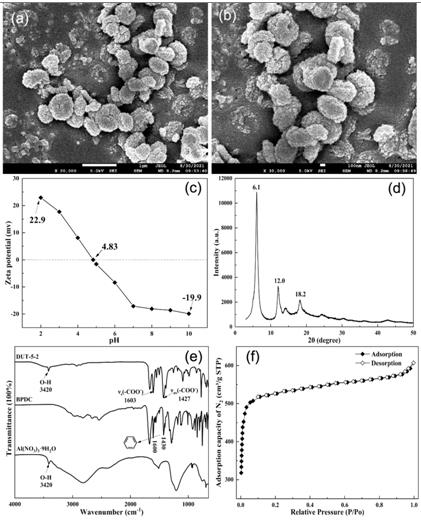Microwave synthesized metal organic framework material DUT-5 (Al) as well as synthesis method and application thereof
A metal-organic framework and DUT-5 technology, which is applied in chemical instruments and methods, other chemical processes, water/sludge/sewage treatment, etc., can solve the problems of long time consumption and low efficiency, so as to improve adsorption efficiency and synthesis Efficiency, the effect of shortening the synthesis time
- Summary
- Abstract
- Description
- Claims
- Application Information
AI Technical Summary
Problems solved by technology
Method used
Image
Examples
Embodiment 1
[0031] Embodiment 1: the synthesis of MOFs
[0032] Synthesis of MOFs by hydrothermal / solvothermal method or microwave-assisted synthesis, the schematic diagram of material synthesis can be found in figure 1 .
[0033] 1. Synthesis of UIO-66
[0034] The traditional solvothermal synthesis method was adopted. According to n (ZrCl 4 ): n (terephthalic acid) = 1:1 ratio, 2.33g zirconium tetrachloride (Zrcl 4 ) and 1.66g terephthalic acid (H 2 BDC) was dissolved in 200mL N,N-dimethylformamide (DMF), stirred until dissolved and loaded into a polytetrafluoroethylene reactor (15.5*7.70 cm, Shanghai Wutong Experimental Instrument Co., Ltd.), at 120°C Under reaction 24h. The product was washed 3 times with DMF and methanol respectively and collected by centrifugation. Finally, the product was dried in a vacuum oven at 120°C for 8 hours to obtain metal-organic framework material UIO-66 crystal, and the UIO-66 crystal powder was sealed and stored for future use.
[0035] 2. Synth...
Embodiment 2
[0047] Embodiment 2: the screening of adsorbent
[0048] To evaluate the synthesized MOFs (DUT-5-1, DUT-5-2, UIO-66, UIO-67, MOF-801, NH 2 -MIL-101 and Co-MOF) on the adsorption performance of PFOS and PFOA, the static adsorption experiment was carried out. Specifically: Add 5 mg of adsorbent to a 50 mL polypropylene centrifuge tube containing 25 mL of PFOS or PFOA solution with a concentration of 30 mg / L. Before adding the adsorbent, add 0.1 mol / L HCl or NaOH Solution Adjust the pH of the PFOS or PFOA solution to 3.0±0.1. These mixtures were placed in a constant temperature shaker (25°C) and shaken at a speed of 150 r / min for 24 h. Samples were taken and filtered with a 0.22 μm filter membrane, and the concentrations of PFOS and PFOA in the solution were determined after filtration. And calculate the adsorption capacity according to formula (1).
[0049] Formula 1);
[0050] Among them: C 0 —Initial concentration of PFOS or PFOA (mg / L);
[0051] C t - remaining con...
Embodiment 3
[0056] Example 3: Research on the Adsorption Behavior of DUT-5-2 to PFOS and PFOA
[0057] 1. Morphology and structure characterization of DUT-5-2
[0058] (1) Scanning electron microscope (SEM) and Zeta potential analysis
[0059] The surface morphology of metal-organic frameworks was observed using a JEOL 7500F scanning electron microscope (SEM). The obtained sample powder was fixed on a stainless steel sample stage with conductive glue, and a layer of gold was sprayed on the surface to avoid electron beam charging. The gold-sprayed sample was placed under a scanning electron microscope at 2.00 KV to observe the surface microstructure of the metal-organic framework.
PUM
| Property | Measurement | Unit |
|---|---|---|
| adsorption capacity | aaaaa | aaaaa |
| adsorption capacity | aaaaa | aaaaa |
| crystallinity | aaaaa | aaaaa |
Abstract
Description
Claims
Application Information
 Login to View More
Login to View More - R&D
- Intellectual Property
- Life Sciences
- Materials
- Tech Scout
- Unparalleled Data Quality
- Higher Quality Content
- 60% Fewer Hallucinations
Browse by: Latest US Patents, China's latest patents, Technical Efficacy Thesaurus, Application Domain, Technology Topic, Popular Technical Reports.
© 2025 PatSnap. All rights reserved.Legal|Privacy policy|Modern Slavery Act Transparency Statement|Sitemap|About US| Contact US: help@patsnap.com



